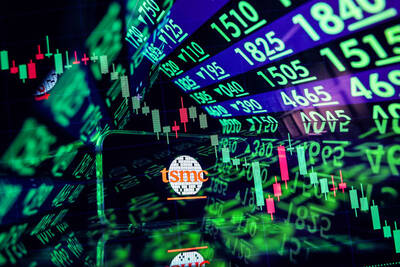The value of export orders for last month dropped 4.7 percent annually, much better than the government’s estimate of a 10 percent decline, but it still marked the 12th month straight of annual contraction in orders, the latest government data showed.
The Ministry of Economic Affairs attributed the better-than-expected results to the stronger-than-expected demand for international smartphone vendors’ new mid-end handsets.
“We were surprised by the results,” Department of Statistics Director-General Lin Lee-jen (林麗貞) said. “The scale of the annual decline last month represented the smallest decline since October last year.”
In addition to Apple Inc’s launch of its iPhone SE, Chinese smartphone vendors also introduced new mid-end handsets to the market last month, allowing Taiwanese components suppliers to receive more orders, which helped narrow the size of the annual drop in export orders last month, Lin said.
However, last month’s results still showed that export orders had declined for 12 straight months, on par with the previous record during the global financial crisis in 2008 and 2009, Lin said.
From January to last month, export orders totaled US$98.48 billion, down 8.3 percent from the same period last year and 19.4 percent less than the previous three months, as orders for all items showed declines across the board, the ministry’s data showed.
Due to a sluggish global economy, orders for information technology products and electronics goods — the pillar of Taiwan’s exports — contracted by 5.7 percent and 2.8 percent year-on-year respectively in the first quarter, Lin said.
Orders for machinery products, base metals, petrochemical and plastic goods, and precision instruments plummeted by a double-digit percentage last quarter from a year earlier, the data showed.
Lin attributed the declining orders for traditional goods to persistently low international oil and stainless steel prices, adding that China’s efforts to cultivate its own panel and petrochemical products also put a lot of pressure on Taiwan’s export orders.
By export destination — apart from to ASEAN, which grew by 1.5 percent annually in the last quarter — the US, China, Hong Kong and Japan all showed an annual decline in orders in the first quarter, data showed.
However, Lin said the 1.5 percent annual growth in ASEAN orders does not fully represent a recovering demand from the region, because most of the orders were placed in ASEAN by US clients.
Lin said that although the export orders showed an annual contraction last quarter, the scale of the decline is shrinking on a monthly basis, suggesting signs of recovery in export orders.
Compared with last year, the global crude and stainless steel prices have become stable in recent months, Lin said, adding that the demand for electronics and information technology goods also improved in the past few months.
Lin said the ministry foresees that export orders could swing back to positive territory this quarter, fueled by an improving demand for smartphones from emerging markets and improving demand for petrochemical and stainless steel products.

Taiwan Semiconductor Manufacturing Co (TSMC, 台積電) last week recorded an increase in the number of shareholders to the highest in almost eight months, despite its share price falling 3.38 percent from the previous week, Taiwan Stock Exchange data released on Saturday showed. As of Friday, TSMC had 1.88 million shareholders, the most since the week of April 25 and an increase of 31,870 from the previous week, the data showed. The number of shareholders jumped despite a drop of NT$50 (US$1.59), or 3.38 percent, in TSMC’s share price from a week earlier to NT$1,430, as investors took profits from their earlier gains

In a high-security Shenzhen laboratory, Chinese scientists have built what Washington has spent years trying to prevent: a prototype of a machine capable of producing the cutting-edge semiconductor chips that power artificial intelligence (AI), smartphones and weapons central to Western military dominance, Reuters has learned. Completed early this year and undergoing testing, the prototype fills nearly an entire factory floor. It was built by a team of former engineers from Dutch semiconductor giant ASML who reverse-engineered the company’s extreme ultraviolet lithography (EUV) machines, according to two people with knowledge of the project. EUV machines sit at the heart of a technological Cold

Taiwan’s long-term economic competitiveness will hinge not only on national champions like Taiwan Semiconductor Manufacturing Co. (TSMC, 台積電) but also on the widespread adoption of artificial intelligence (AI) and other emerging technologies, a US-based scholar has said. At a lecture in Taipei on Tuesday, Jeffrey Ding, assistant professor of political science at the George Washington University and author of "Technology and the Rise of Great Powers," argued that historical experience shows that general-purpose technologies (GPTs) — such as electricity, computers and now AI — shape long-term economic advantages through their diffusion across the broader economy. "What really matters is not who pioneers

TAIWAN VALUE CHAIN: Foxtron is to fully own Luxgen following the transaction and it plans to launch a new electric model, the Foxtron Bria, in Taiwan next year Yulon Motor Co (裕隆汽車) yesterday said that its board of directors approved the disposal of its electric vehicle (EV) unit, Luxgen Motor Co (納智捷汽車), to Foxtron Vehicle Technologies Co (鴻華先進) for NT$787.6 million (US$24.98 million). Foxtron, a half-half joint venture between Yulon affiliate Hua-Chuang Automobile Information Technical Center Co (華創車電) and Hon Hai Precision Industry Co (鴻海精密), expects to wrap up the deal in the first quarter of next year. Foxtron would fully own Luxgen following the transaction, including five car distributing companies, outlets and all employees. The deal is subject to the approval of the Fair Trade Commission, Foxtron said. “Foxtron will be